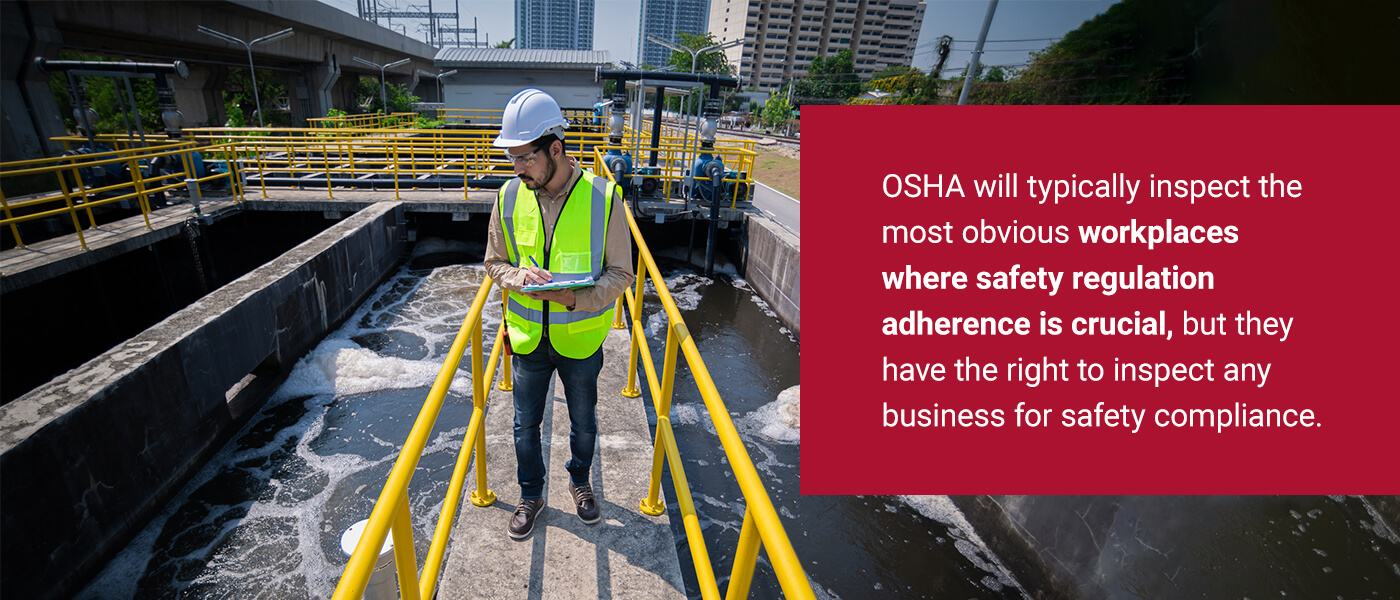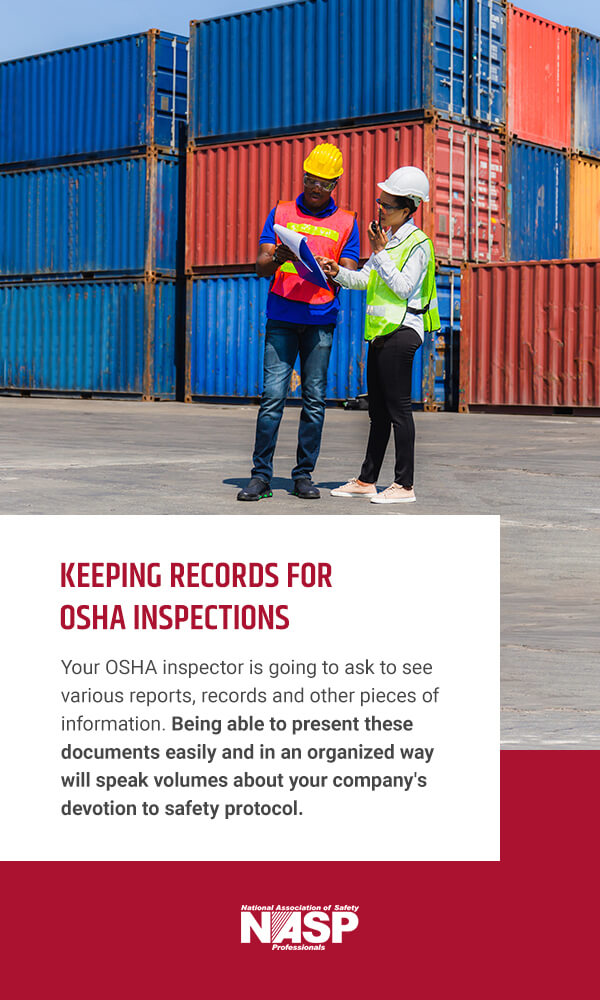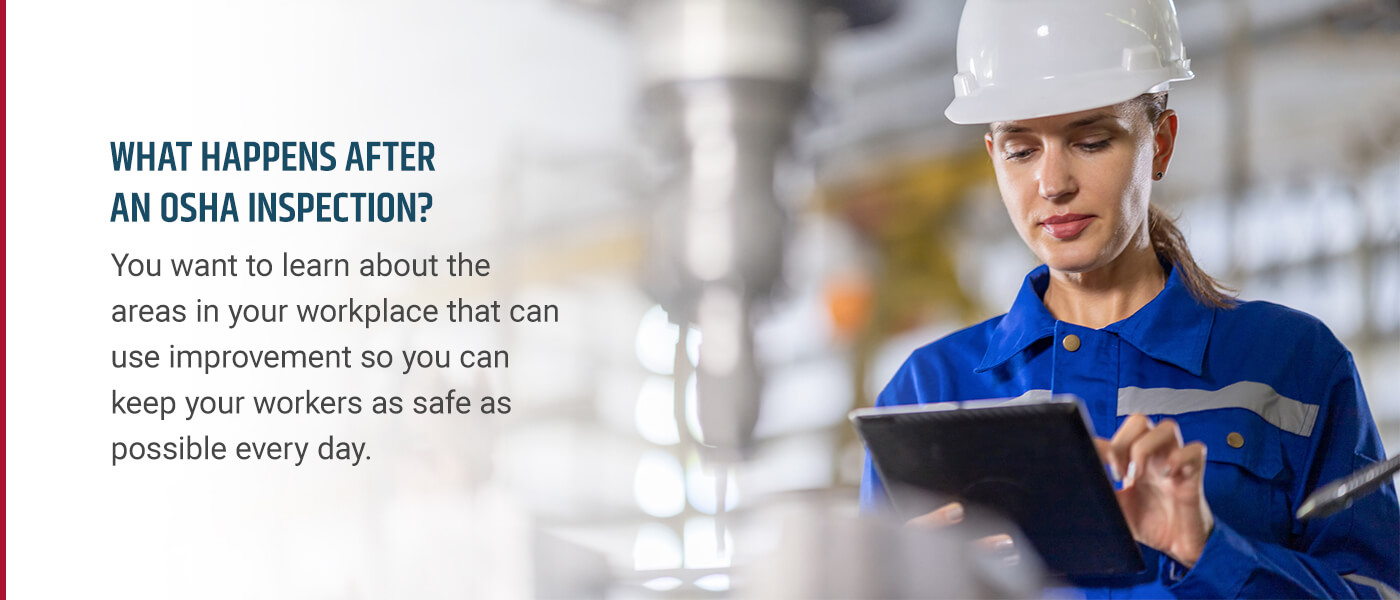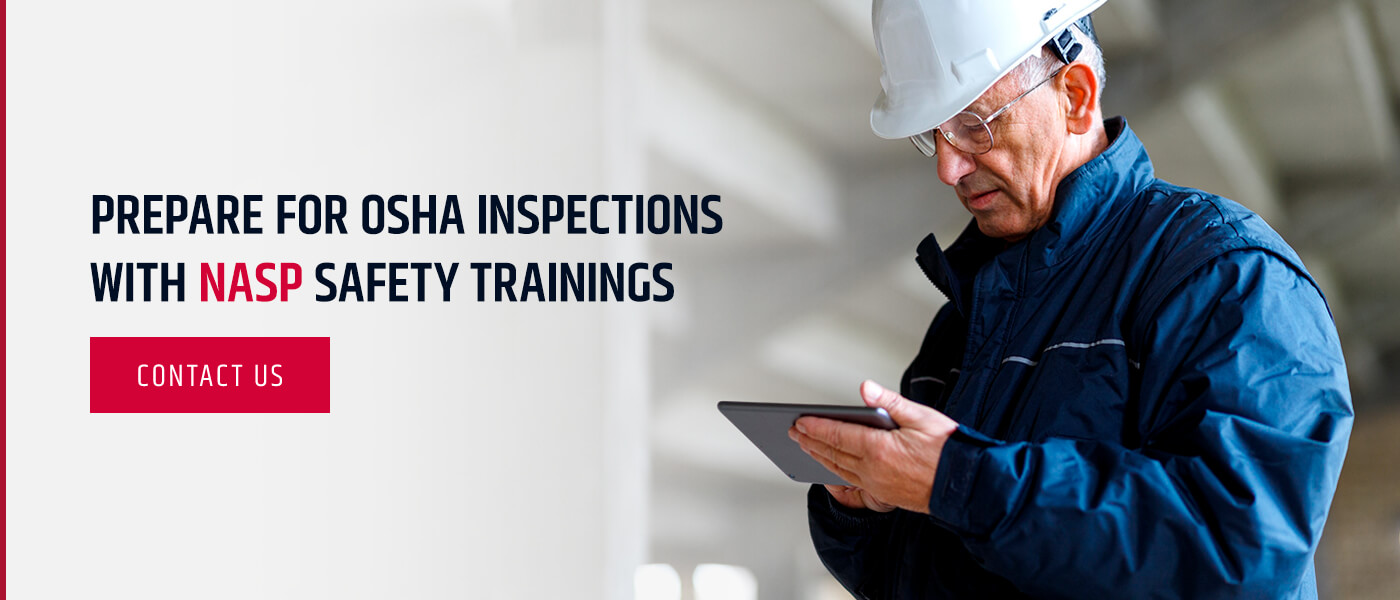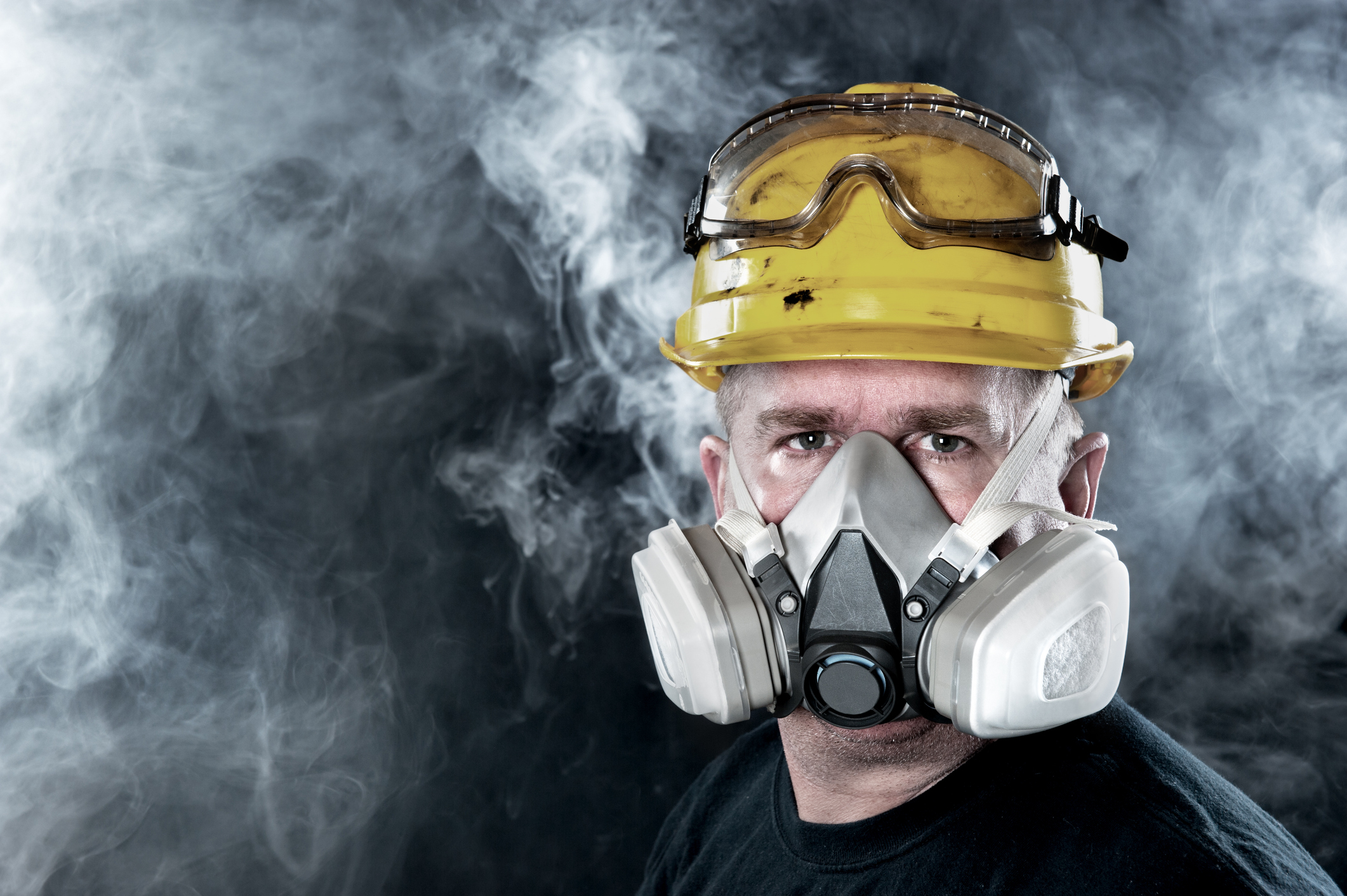Guide to OSHA Inspections
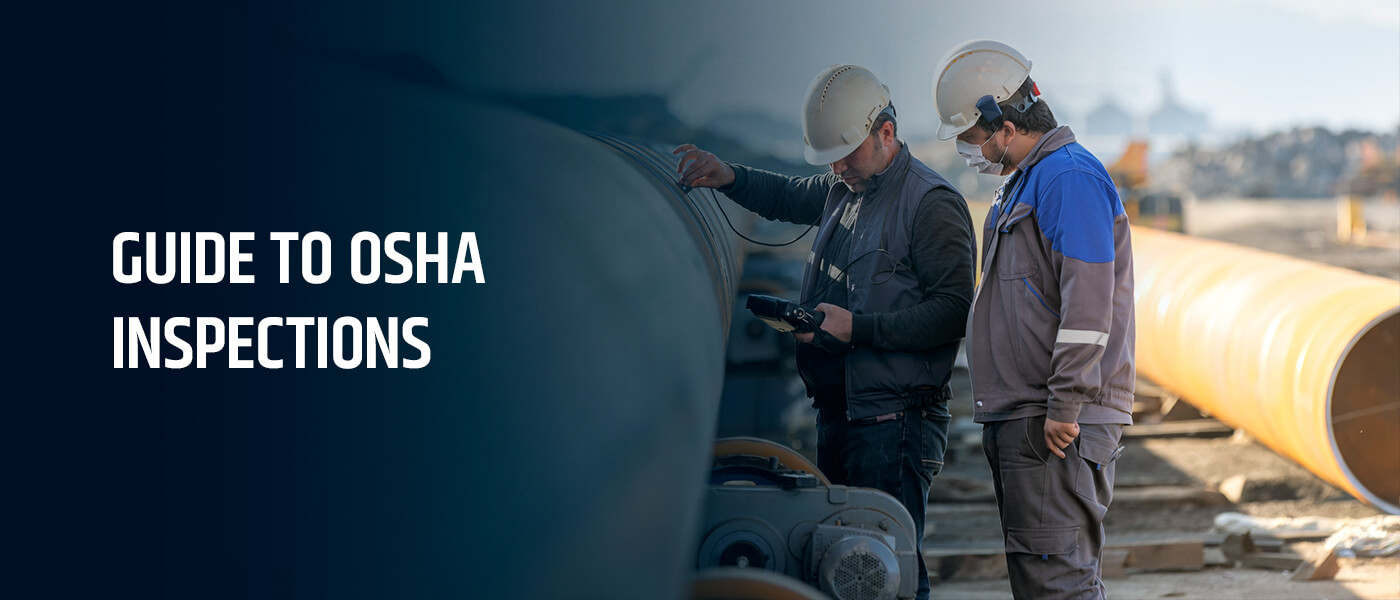
OSHA inspections — the simple act of reading that term is enough to worry or frustrate safety professionals, managers and business owners across industries. But the good news is that you can take a different approach to OSHA inspections for your business by taking a proactive approach before, during and after every OSHA inspection.
With the right outlook and preparation, you can remove all negative feelings toward OSHA inspections and let them be what they’re supposed to be — something that helps increase the safety of your workplace for the well-being of your employees and team members. As a safety professional, you must know how to prepare for an OSHA inspection to ensure your business handles your inspection the right way and can experience the benefits of a safer workplace.
What to Expect From an OSHA Inspection
Handling OSHA inspections the right way starts with knowing what to expect. First, make sure you know who OSHA is. The Occupational Safety and Health Administration (OSHA) is a part of the United States Department of Labor that works to ensure healthful and safe working conditions for workers by creating and enforcing standards. OSHA also provides outreach, training, assistance and education to further their cause of cultivating safer workplaces.
Next, know that workplaces rarely receive OSHA advance notice before the inspector arrives. With this in mind, it’s important to expect the unexpected by always being ready for an OSHA inspection. The last thing you want to do is assume that OSHA will overlook your business because other workplaces deserve an inspection more. This is faulty thinking, and it leaves businesses across the country unprepared for OSHA inspections every day.
During an OSHA inspection, OSHA will send a certified inspector to your workplace. They should show credentials immediately, but if they delay this formality, request to see their credentials before letting them into the premises. If you have any suspicions about the validity of the inspector, call your local area’s OSHA director to be sure. After letting the OSHA inspector into your premises, kindly place them in a waiting room while you notify managers, employees and any other relevant parties that OSHA is on the premises.
Most OSHA inspections follow a similar pattern, which includes an opening conference, a walkaround and the closing conference. These steps each have different things you should know about them, outlined in further detail in the section below.
OSHA must complete its inspections within six months of the start date. Therefore, you should expect the OSHA inspector to return any day within those six months, if they have the necessary reason to do so. Note that these drawn-out inspections are quite rare, and most inspections should only take a few days before their completion.
Who Does OSHA Typically Inspect?
OSHA devotes the majority of its efforts to the most hazardous sites found within workplaces. OSHA will also single-out companies whose employees file official complaints or companies mentioned in referrals by organizations, agencies or the media. In other words, OSHA will typically inspect the most obvious workplaces where safety regulation adherence is crucial, but they have the right to inspect any business for safety compliance.
Since all businesses must report serious injuries and fatalities to OSHA, OSHA knows which industries put employees at the most risk. Construction workers are a good example of a high-risk job, with one in five worker deaths occurring in the construction industry in 2019. Thus, construction worksites are a likely candidate for an OSHA inspection.
How to Prepare for an OSHA Inspection
Preparing for the Inspection is as important as properly handling the actual inspection. Here are five ways you can prepare for a random or expected OSHA inspection.
1. Performing Hazard Assessments Before OSHA Inspections
OSHA requires employers to perform a job hazards analysis for every type of job that employees will perform within the workplace. OSHA defines the term “hazard” as the potential for harm. This means that hazards can take many forms, and one industry’s common hazards may be different than another industry’s. A job hazard analysis shows OSHA what hazards exist on a specific job site and how employers plan to reduce those hazards.
OSHA requires this analysis so you can better identify hazards on your job site or within your workplace before they happen. It focuses on the relationship between workers, their environment, the tools used for the task and the task itself. The proper response for a hazard assessment is to take the necessary steps to reduce hazards to an acceptable level or eliminate them. Doing this before an OSHA inspection will help you receive better inspection results when the time comes.
2. Performing Safety Trainings Before OSHA Inspections
Your OSHA inspector is going to check whether your employees have received the proper safety training to safely perform their tasks. Employee safety training should also be up-to-date, meaning an employee’s safety certificates should be current and recently achieved.
You may need to present proof of your employees’ completed and current safety training, as it may be impossible for the OSHA inspector to check each employee individually. One easy way to prove your employee’s safety training is up-to-date is to conduct safety training online. Online safety training keeps digital results readily available and encourages employees to keep up with their safety training at their own pace, encouraging greater retention and completion rates.
3. Keeping Records for OSHA Inspections
One of the best ways you can prepare for an OSHA inspection is to keep good records every single day. Your OSHA inspector is going to ask to see various reports, records and other pieces of information. Being able to present these documents easily and in an organized way will speak volumes about your company’s devotion to safety protocol.
Keep records of every training course your employees complete. Also, ensure every employee knows your company’s safety policies and the location where you’ve posted them throughout your facility. Have every employee sign their name to prove they have understood your safety policies and completed certain training. Have a report of employee complaints available with information proving you’ve addressed and handled each complaint.
Other documents and records to have ready include worker compensation files, training records, third-party audits and insurance claims.
4. Performing Internal Audits Before OSHA Inspections
Third-party audits are a great way to get objective feedback about the true success of your safety program. But an internal audit, while hard to keep completely bias-free, is also an excellent way to learn more about your workplace’s current safety levels before an OSHA inspector shows up at your doorstep.
As a safety professional, you can oversee internal audits to get the crucial information you need on how your safety program is performing. Use your findings to make changes where necessary and find areas of potential noncompliance you may have been unaware of. If you conduct internal audits periodically throughout the year, you’ll feel much more confident when facing an unexpected OSHA inspection.
5. Preparing Your Employees for OSHA Inspections
Making sure your employees are prepared for an OSHA inspection is crucial to receiving a good report. Start by informing your employees of their rights throughout an OSHA inspection. For instance, your employees are not obligated to speak to the inspector, but you should encourage them to respond truthfully if they do choose to respond. Employees may deny the inspector the request to record any conversations that do occur.
Your employees can also deny the request to sign a witness statement. Any employees that do sign a witness statement should read the entire statement before signing their name to ensure it is correct. If an employee is unable to read the language present on the statement, they have the right to ask the inspector to present them with one in their native language before signing it, even if the inspector has to return on another day to fulfill that request. Make sure employees request a copy of any witness statements they sign.
The OSHA Inspection Process
Once you’ve made the appropriate preparations, you’ll be in a better position to handle an official OSHA inspection. Each OSHA inspection has three main parts with some important things to know for each step.
The Opening Conference
The inspector should call for an opening conference before proceeding with the inspection. You have the right to request an opening conference if the inspector tries to skip this step. Gather the proper managers and safety professionals and grant permission to the inspector to begin. From there, the inspector will conduct a brief conference to talk about their reasons for inspecting your workplace. Reasons may include fulfilling a random inspection requirement, responding to a complaint or a recent workplace injury or fatality.
Next, the inspector will outline the scope of the inspection, including where they will focus their inspection and whether they wish to conduct employee interviews. Your employees can choose whether they want the interview to be private or occur in the presence of a manager.
The Walkaround
Once the opening conference is complete, the OSHA inspector will begin their walkthrough of the facility. They’ll take photographs and write down notes throughout the process. You or another trusted safety professional should accompany the OSHA representative on their walkaround, keeping notes on what the inspector does and taking pictures of whatever the inspector takes pictures of for your records. Expect the inspector to take air samples, make video recordings, record instrument readings, measure noise levels, test for toxic fumes and more during the walkaround.
Designate an employee representative to attend the walkaround, as well. OSHA requires that employees have a representative for the inspection if they have requested one, even if the employees are not unionized.
Note that the walkaround can cover any part of your facility, even sections that the inspector failed to mention during the opening conference. If the inspector finds a safety violation in open sight, they may ask your permission to expand the inspection.
The Closing Conference
After the walkaround, the OSHA officer will call for key company representatives and give a closing conference. The inspector will share the information they gathered, namely, any violations or unsafe working conditions. This will inform you of the next steps you should take, which you can learn more about in the following sections. Correct any deficiencies the inspector noted before they leave the building if possible to reduce the potential for citations and show your commitment to a safer working environment.
What Happens After an OSHA Inspection?
After an OSHA inspection, you will probably have a list of various deficiencies and shortcomings regarding your safety program — and that’s okay. Part of reframing your feelings toward OSHA inspections and preparing for them is to understand that they are for the greater good. You want to learn about the areas in your workplace that can use improvement so you can keep your workers as safe as possible every day.
With this in mind, use the time after an inspection to review the inspection report with your safety team, managers and other vested parties. As a team, start planning and implementing changes to correct each noted deficiency. Then, write a follow-up letter to the inspector that addresses his concerns, describing the action you took to correct each shortcoming in your safety program.
OSHA Citations
In some circumstances, you may receive an OSHA citation due to your safety deficiencies. An OSHA citation is a written description of the safety violation with an included reference to the provision of the Act, rule, standard or regulation violated. Citations also include the timeframe in which the offending party should address the safety violation.
Should you receive a citation, you should receive it within half a year of the completed inspection from your local area director. Once receiving a citation, you must follow the included instructions for remedying the situation, including posting the citation in a prominent location within the workplace for easy employee access.
OSHA Contests and Informal Conferences
You may elect to contest any citations you receive within 15 days after your inspection. To do this, you must file a case with the review commission. You can also request an informal conference to discuss issues related to your citations, the proposed penalties, your notice of intent to contest or the inspection as a whole. This conference must occur within the 15-day contest period.
During the conference, OSHA officials will discuss the following:
- The conference’s purpose
- Participants’ rights
- The contest rights and time constraints
- The settlement potential of any of the citations from the inspection
Also, understand your right to an OSHA inspection. At any point, you can complete an official OSHA complaint form and have a meeting to discuss any imminent dangers on your job site or within your workplace. Calling for an OSHA inspection is a wise decision when you feel you need the help of OSHA to determine areas in your workplace that need improvement for the safety of your workers.
Prepare for OSHA Inspections With NASP Safety Trainings
One of the most important things you can do to prepare for an OSHA inspection is to make sure your safety training is up-to-date. The National Association of Safety Professionals (NASP) offers online safety training so you can get the safety certificates you need to stay OSHA-compliant and advance your career as a safety professional.
Browse our full course catalog today to find the online test that suits your needs as you prepare for a potential OSHA inspection. Feel free to contact us online if you have any questions.
Blog Posts
Latest Posts
Related Posts


